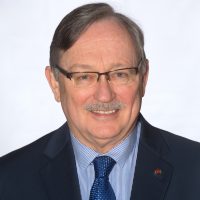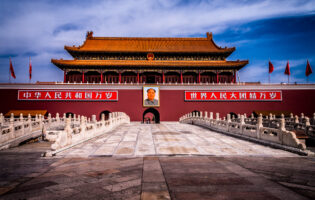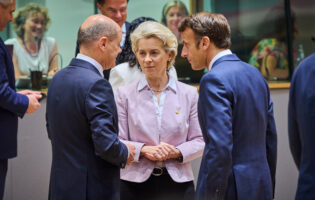The Miracle of Leipzig

James D. Bindenagel
University of Bonn
James D. Bindenagel is a retired U.S. Ambassador, Henry-Kissinger-Professor (Emeritus) at Bonn University, and Senior Non-Resident Transatlantic Fellow at the German Marshall Fund of the United States. He has published: Germany: From Peace to Power? Can Germany Lead in Europe without Dominating it? (2020) and International Sicherheit im 21. Jahrhundert, Deutschlands Verantwortung (2015), both published by V&R Bonn for Bonn University.
This is a story about the secret of freedom—courage. Germans in Leipzig courageously faced down a regime that had killed fellow citizens, whose only crime was to seek freedom and escape over the Berlin Wall.
East German leader Erich Honecker predicted in January 1989 that the Berlin Wall would last 100 years.
Would it?
In the East German summer of 1989, fear filled the air.
In Beijing, on Tiananmen Square the People’s Liberation Army brutally crushed the student demonstration for democracy. That violent act became known in East Germany as the “China Solution.”
In Europe, hope was stirred when on May 2, the Hungarians dramatically cut down the barbed wire fence along their border and opened it to East Germans fleeing their country.
In Warsaw, it was political High Noon when the Solidarity Movement won seats in the communist parliamentary election for the first time.
And in Leipzig, thousands—and eventually hundreds of thousands—of East Germans would take to the streets each in search of freedom.
In East Berlin, the U.S. Embassy stood watch and expected the Soviet Army would almost certainly follow the Chinese example and intervene in East Germany to save it from an uprising, as the Soviets had done in East Berlin in 1953.
Honecker had allowed peace vigils in the churches early in the 1980s to protest NATO missile nuclear deployments and to support protests in West Germany. Pastor Christian Führer from the Nikolai Church in Leipzig had convened peace vigils and continued them in 1989 long after the missiles were deployed.
Honecker himself was challenged to accept Soviet President Mikhail Gorbachev’s reform for Glasnost and Perestroika. East Germans used Gorbachev as protection as they protested in the streets against Honecker, but not to deny the legitimacy of the East German state.
Monday peace vigils led by Pastor Führer at Nikolai Kirche became the way to speak out for peace and freedom of travel. Street demonstrations followed after the Monday night peace vigil. Starting at 5 o’clock, small numbers of people would leave the church, walk past the Stasi office to march on the Leipzig City Ring. The marches were carefully crafted to talk about renewal of the GDR for freedom to travel, a better socialism, not revolution. The demonstrators did not want to face violence and death.
While the Germans were organizing their opposition, American Embassy officers were talking with as many people as possible and were reporting to Washington as the face-off neared.
Fear of violence was palpable. Would the “Shoot-to-Kill” order be carried out?
In the U.S. Embassy we expected and feared a violent clash between the demonstrators and the police would end in bloodshed. An Embassy political officer, Imre Lipping, was in Leipzig ready to report.
On Monday, October 9, 1989, all eyes turned and focused on Leipzig. Leipzigers feared for themselves, for friends and those around them. They feared those in uniforms standing against them. They feared for their country.
Families had split up so one parent could stay with the children, if the other parent died in the demonstration. Seventy thousand courageous people would demonstrate—the largest anti-government demonstration in East Germany.
Gewandhaus Orchestra Conductor Kurt Masur would later see the events as revolutionary and recalled what he thought that afternoon: “When 17- and 18-year-olds said goodbye to their parents that day, it was like they were heading off to war. But everyone had had enough. All of them—all 70,000 of them—were able to overcome their fears.”[1]
There was good reason to fear. Honecker had banned the press and was willing, maybe even eager, to draw blood. Hospitals restocked blood supplies and doctors’ leaves were cancelled. The Leipzig police had gathered, joined by reinforcements, and the army was put on alert. The police, backed by the army, were prepared to stop the counterrevolutionaries with the “Chinese Solution.” All signs pointed to Honecker’s willingness to use violence.
Could the October 9 demonstration be kept from turning bloody? Kurt Masur was worried. He, too, knew reports of demonstrations in many cities that had seen stones thrown, windows smashed, cars burned and police with rubber truncheons and water cannons beating back protestors. Even the previous Monday demonstration in Leipzig ended in violence.
If necessary, the protest that night would be broken up by force of arms. Yet the people were desperate for their freedom.
One of the dissident movement groups, “Neues Forum,” heard that military units were deployed all around Leipzig. They called Masur for help. Masur turned his office at the Gewandhaus into a communications center that day.
Masur called Kurt Meyer, the Communist Party’s cultural representative, who returned the call two hours before the march and gathered a small group of six people at his house. The three Communist Party representatives had not received specific instructions from Berlin and were constantly telephoning but to no avail.
Masur described the group as a miniature version of all the people—a theologian, a cabaret performer, three district secretaries for the ruling Socialist Unity Party (SED), and Kurt Masur himself. They drafted and rushed to sign an appeal for non-violence. When they had an agreed text, Masur recorded the appeal.
Outside, as the demonstrators faced the police, the situation threatened to escalate. Loudspeakers broadcast Masur’s voice with the appeal: “We urgently request that you remain calm so as to make peaceful dialogue possible.”
Violence would leave eternal bloody wounds. The call went out: Keine Gewalt! (No violence!) And: “Wir sind das Volk.” (We are the people.)
The marchers took to the Leipzig Ring Road and remained peaceful. The police did not attack the crowd. Violent confrontation was avoided, despite some isolated confrontations on the fringes.[2]
But how did the peace hold in Leipzig? Could it hold elsewhere? We in the Embassy thought Gorbachev’s Glasnost and Perestroika were at risk if there were violence. Maybe Masur’s communist collaborators played politics supporting Gorbachev, rather than Honecker. They likely were not making an altruistic gesture toward the demonstrators.
The police and communist leaders had waited for orders from Berlin. Maybe East Berlin simply ignored the plan to broadcast the Masur message calling for no violence.
Orders never came and no one carried out the shoot-to-kill order. No shots were fired. That was the Miracle of Leipzig.
That night Leipzig set the 1989 Peaceful Revolution in motion. A few days later Honecker was ousted.
A month later on November 9, I attended a reception at the Aspen Institute Berlin and afterward gave Wolfgang Vogel, Honecker’s lawyer, a ride back into the city. He told me the Politburo had decided on changes to the hated travel law. Egon Krenz, who succeeded Honecker, would implement them soon.
Not one of us had an inkling the Berlin Wall was about to fall on that November 9 and turn the world upside down.
Minutes after I arrived back at the U.S. Embassy, the East German spokesman Gunter Schabowski announced on television new rules to ease travel. East Germans could get visitor visas quickly (“kurzfristig”) for travel to the West from their local “People’s Police.” An Italian journalist asked when the new rules would go into effect, and Schabowski fumbled with his papers and mumbled—immediately (“sofort, unverzüglich”).
With that NBC reporter Tom Brokaw left the East German press conference and, as an eyewitness, broadcast on American TV his understanding of the announcement: The Berlin Wall was open.
Jon Greenwald, the Embassy political officer, scrambled to get the official word, and cabled the text of Schabowski’s announcement to Washington.
As that cable arrived in the White House and State Department, I telephoned the White House Situation Room and State Department Operations Center, spoke to the Watch Officers, and made sure they had the Embassy’s report before the president had to make a statement on the unfolding events.
After alerting Washington and establishing an on-going reporting channel, I headed to my East Berlin home in Niederschönhausen around 10:00 PM.
On the way I suddenly saw in the distance a confrontation at the Bornholmerstrasse checkpoint along the Berlin Wall. A steadily growing number of demonstrators was gathering at the checkpoint—anxious East Germans, hoping to have a glimpse of West Berlin.
They were shouting at the guards defending the crossing. I heard them saying something, but couldn’t understand exactly what it was they were yelling, maybe TOR AUF! (OPEN THE GATE!) Those brave souls grew in numbers and confidently demonstrated courage in face of the border guards.
They confronted the East German border guards still charged with protecting the crossing with “shoot-to-kill” orders. Lieutenant-Colonel Harald Jäger was ready to carry out orders to defend the Wall and called for instructions. Fire hoses, like those used later at the Brandenburg Gate, were carefully laid out in readiness to repel any wall jumpers. Inside the crossing, armed border police waited.
Running through my mind was whether Soviet Army soldiers would stay in their barracks. Collectively, we believed the conventional wisdom that predicted Gorbachev would intervene. There were 380,000 Soviet soldiers in the country. There was no sign that the military superpower Soviet Union would give up East Germany without a fight.
Just minutes later, I witnessed the breach of the Berlin Wall on West German TV. The Berlin Wall was breached at Bornholmerstrasse, where I left just minutes earlier.
First, a wave of East Berliners came through the checkpoint signaling freedom for all East Germans. Then another wave of people streamed across the bridge and West German television flashed their pictures around the world. They were free!
East Germans mustered the courage to storm the Berlin Wall that had imprisoned them for decades, thus revealing the secret of freedom: Courage to overcome fear.
The fall of the Berlin Wall is for the East Germans what the storming of the Bastille 200 years ago is for the French: the end of the old order and the beginning of a new one. Leipzig set the course for the non-violent Peaceful Revolution.
The transition to freedom and democracy has been hard for many East Germans whose lives were turned upside down. The economy collapsed and jobs were lost. Homes were claimed by former owners. Wages of the employed would be a fraction of those in the West.
Now twenty-five years later all of us can celebrate the peaceful fight for freedom: The Miracle of Leipzig.
Ambassador J.D. Bindenagel is the Former Minister of the U.S. Embassy to East Germany, 1989-1990. This article was originally presented as a speech at the Baker Institute for Public Policy at Rice University on November 2, 2014.
[1] Interview With Conductor Kurt Maser: “The Spirit of 1989 Has Been Exhausted,” Der Spiegel, 12 October 2010, http://www.spiegel.de/international/germany/interview-with-conductor-kurt-masur-the-spirit-of-1989-has-been-exhausted-a-721851.html
[2] Ibid.








